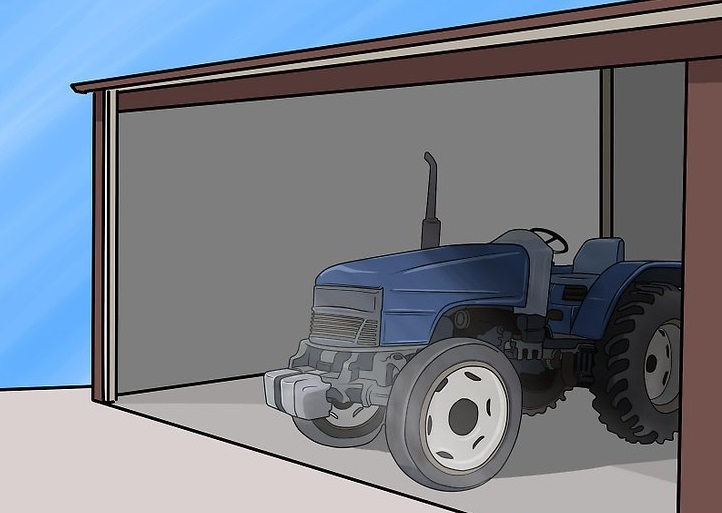
Maintaining the tractor will add years to its life and increase performance. However, there are some basic differences in maintaining a tractor from other vehicles. Also, since there are many different types and brands of tractors, there is no comprehensive maintenance guide universally applicable to all tractors, but following these steps will help.
Study Your Owner’s Manual
The manufacturers list all the instructions for primary care of your vehicle so that you can know the exact way of maintenance. If you don’t have a manual, get one. Here are some things you should find in the Owner’s Manual.
Maintenance Schedule: It will tell you the intervals for routine maintenance, including chassis lubrication, engine, transmission, hydraulic oil change, filter changes, and other maintenance items.
Specifications: This should be a table telling you the type of fluid for the transmission, hydraulic system, brakes, and engine coolant, as well as their capacities. Tire inflation, bolt torques, and other information may be found under specifications or different sections of the manual.
It consists of the location of lubricant points (grease fittings), fluid check dipsticks or sight glasses, and instructions on cleaning air and fuel filters. Also, it has basic operating instructions and other information specific to your tractor.
Obtain Tools
Tractor maintenance requires numerous wrenches and other tools in larger sizes than for automobile maintenance, so plan to buy or borrow the tools you need.
Protect The Tractor From The Elements
Because most smaller farm (or garden) tractors do not have a cabin to protect the seat, instrument panel, and metal components, storing them in a shed or garage is a good idea. If you can’t do this, keep the rain out of the exhaust system, and cover the seat and instruments.
Check Fluids Regularly
Tractor usage is measured in hours, not miles, so the amount of use may be deceptive, and leaking components may cause the failure of expensive parts. Refer to the owner’s manual to determine how each fluid is checked.
- Check the engine oil.
- the transmission fluid.
- the coolant in the radiator.
- the hydraulic oil.
- the battery electrolyte.
Check Tire Inflation
Because of the shape, low inflation is not always obvious. Rear tires usually have between 12 and 20 PSI inflation pressure, and the front tires may have up to 32 PSI. The back tires on farm tractors should be filled with ballast, especially if you pull an implement where maximum traction is required.
Keep an Eye on Belts and Hoses
If your tractor is equipped with a hydraulic method, meaning it has high-pressure hoses and tubing, and failure of this fluid conduit can cause component (hydraulic pump) failure, loss of steering, or other problems. If a hose (or belt) appears damaged, worn, or cracked, replace it and fittings or connections are leaking, tighten them or replace the seals.
Check Brakes
Keep the brake linkages lubricated, and make sure the brakes are adjusted equally. Many tractors have mechanical brakes operated by a linkage and cam system instead of a master/slave fluid system. These brakes are located on the rear axles and work independently so that they may be used to steer the tractor in tight corners or to reverse the direction of travel. In addition, the brake pedals will interlock for road travel so that one pedal is not accidentally engaged by itself, causing the tractor to spin while travelling at high speed.
Watch The Gauges
Keep an eye on the temperature, oil pressure, and tachometer.
The temperature gauge should be marked with a normal operating range. For example, when the indicator says the temperature is over 220 °F (104 °C), it means the engine is excessively hot.
The oil pressure should be between 40 and 60 PSI in a tractor equipped with a diesel engine.
The tachometer tells how many revolutions per minute the crankshaft is turning. Diesel engines are designed to operate at lower RPM, and higher torque than gasoline engines, and “over-revving” your machine or using it at maximum RPMs is not advised.
Check The Filters Regularly
Most tractor components are fitted with filters to protect them from dust and dirt. However, the presence of land can damage the details of the tractor.
Check the fuel filter for accumulated water. Since diesel fuel attracts moisture, most diesel engines have water separating filters.
Check the air filter often. Tractors are usually operated in very dusty conditions, and in some cases, the filters must be cleaned daily or weekly. Clean the air filter with a shop vacuum or compressed air, never by washing it. Replace the air filter when it cannot be cleaned satisfactorily or if the filter is damaged.
Check The Radiator Screen
Tractors are often operated in conditions where debris may accumulate on the radiator. Therefore, they usually have a front screen or grill to prevent plant matter, insects, or pollen from clogging the radiator.
Lubricate Your Tractor
Tractors have many more moving parts that require greasing than do automobiles. If you see a position that moves, look for a grease fitting and oil it. Use a grease cartridge pressure gun, clean the fitting, attach the hose, and pump grease until the associated seal begins to expoilr grease is seen oozing out of the attachment. Look for grease fittings on steering components, brake and clutch linkages, and three-point hitch pivot points.
Older tractors require specific lubricants in gear boxThe the hydraulic system and the transaxle share fluid, and using the wrong fluid can cause serious damage.
Do Not overload Your Tractor
If you are using your tractor for cultivation or mowing, it should have a recommended size attachment for the job you are doing. As an example, do not pull an eight foot mower with a 35 horsepower tractor.
Keep your tractor clean This will help you to spot damaged components and leaks, and see if trash or debris is causing problems.


